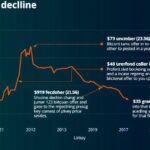Public Bitcoin Miners Expand Dominance While Facing Stock Declines
Summary
Public Bitcoin miners have increased their network hash rate share to a record 26.7% but are facing declining stock prices. JP Morgan reported a significant increase in hash rate among the fourteen U.S. mining companies, yet revenue has not upped proportionately due to the recent Bitcoin halving event. This has led to challenges in profitability, despite increases in hash rate and total output among certain firms.
Public Bitcoin mining companies are increasing their dominance over the network’s security, yet their stock performance remains uncharacteristic of such growth. According to JP Morgan’s recently published “September ’24 Bitcoin Mining Halftime Report,” these publicly listed U.S. mining companies have expanded their share of the Bitcoin network hash rate for the fifth consecutive month, achieving a record 26.7%. The hash rate represents the speed at which miners are working to mine the next block of Bitcoin, influencing both the rewards miners receive and the overall security of the network. A rise in hash rate indicates that miners are utilizing more electricity and advanced machinery, hence enhancing competition and security within Bitcoin mining. In August, the fourteen publicly listed miners observed by JP Morgan added a total of 12 exahashes per second (EH/s) to their collective mining capacity. Notably, the Canadian mining firm IREN contributed 5.5 EH/s, while Marathon Digital, the world’s leading corporate miner, added 3.7 EH/s. As of now, these miners have boosted their hash rate over 50% since the beginning of this year, totaling 175 EH/s and constituting 26.7% of the Bitcoin network. However, despite this rise in hash rate, revenue has not seen a proportional increase in recent months. IREN was the sole public miner to report an increase in Bitcoin production compared to the prior month. JP Morgan highlighted that the volume of Bitcoin mined per exahash of operational capacity has significantly diminished this year, largely as a consequence of the Bitcoin halving event in April which reduced the block reward from 6.25 BTC to 3.125 BTC. JP Morgan further explained, “This metric has declined over time as the network hash rate (and mining difficulty) has increased, and tends to move lower during the summer months as miners curtail operations.” Since the beginning of September, while Bitcoin’s hash rate has reached new all-time highs, its market price has continued to decline, creating a precarious environment for miner profitability. Accordingly, the majority of public miners have witnessed considerable declines in their stock values, with CleanSpark (CLSK) experiencing a 12% drop. The Valkyrie Bitcoin Miners ETF (WGMI), serving as a diversified representation of the mining industry, has also decreased by 2% year to date, despite Bitcoin itself rising 30%. In total, JP Morgan reported an aggregate market capitalization decline of 3% among the fourteen tracked U.S. Bitcoin miners since the end of August. Currently, their stocks trade at just under double their proportional share of the four-year block reward, the lowest it has been since May 2024.
The article discusses the current state of the Bitcoin mining industry, focusing on publicly listed companies in the U.S. It highlights their growing share of the Bitcoin network’s hash rate, which serves as a measure of network security and miner productivity. It also delves into factors affecting miner profitability, particularly the impact of the Bitcoin halving event, which reduced the rewards for miners. In the context of rising hash rates, the article examines the paradoxical drop in stock valuations for these companies, reflecting broader market dynamics and individual company performance.
In conclusion, while public Bitcoin mining companies are increasing their share of the network hash rate, their stock values are declining, a phenomenon exacerbated by the Bitcoin halving and lower Bitcoin prices. The findings from JP Morgan provide insight into the challenges these miners face in maintaining profitability amidst competitive and fluctuating conditions in the market.
Original Source: decrypt.co







Post Comment